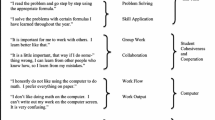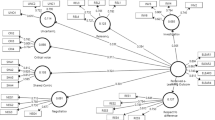Abstract
This article describes the adaptation and validation of the Constructivist OnLine Learning Environment Survey (COLLES) for use in the transnational higher education context. As higher education becomes a more global phenomenon, ‘borderless’ education, either online or by distance education, is becoming a reality and there is a need for remote evaluation of course delivery and student learning. Curtin University of Technology is managing supported online delivery of Business Studies Degree and Diploma courses to four partner institutions of the African Virtual University, an initiative based in Nairobi, Kenya. Evaluation of students’ learning has included an online survey about the provision of resources and the quality of the learning environment in the various computer-based classrooms. Embedded in this instrument has been the adapted COLLES, providing a concomitant opportunity to test the properties and usefulness of the learning environment instrument. Problematic issues surrounding adaptation of the instrument have included the consequences of modifying the wording and establishing or confirming the meaning of the latent constructs in partially online courses and for transnational students. The process of establishing the validity and reliability of the scales is discussed.
Similar content being viewed by others
References
Adam, L. (2003). Information and communication technologies in higher education in Africa: Initiatives and challenges. Journal of Higher Education in Africa, 1(1), 195–221.
Aldridge, J. M., Laugksch, R. C., & Fraser, B. J. (2006). School-level environment and outcomes-based education in South Africa. Learning Environments Research, 9(2) DOI. 10.1007/s10984-006-9009-5.
Aldridge, J. M., Laugksch, R. C., Seopa, M. A., & Fraser, B. J. (2006). Development and validation of an instrument to monitor the implementation of outcomes-based learning environments in science classrooms in South Africa. International Journal of Science Education, 28, 45–70.
Beebe, M. A. (2004). Creating e-quality in Africa: Networking for learning. In P. T. Zeleza & A.␣Olukoshi (Eds.), African universities in the twenty-first century (Vol. 1 Liberalisation and Internationalisation, pp. 187–208). Dakar, Senegal: Council for the Development of Social Science Research in Africa.
Benigno, V., & Trentin, G. (2000). The evaluation of online courses. Journal of Computer Assisted Learning, 16, 259–270.
Collis, B. (1999). Designing for differences: Cultural issues in the design of WWW-based course-support sites. British Journal of Educational Technology, 30, 201–215.
Department of Education, Science and Training, Australian Government. (2005). A national quality strategy for Australian transnational education and training: A discussion paper. Canberra, Australia: Commonwealth of Australia. Retrieved June 1, 2005, from http://www.dest.gov.au/sectors/international_education/publications_resources/.
Fisher, D., Henderson, D., & Fraser, B. (1997). Laboratory environments and student outcomes in senior high school biology. American Biology Teacher, 59, 214–219.
Fraser, B. J. (1998). Science learning environments: Assessment, effects and determinants. In B.␣J.␣Fraser & K. G. Tobin (Eds.), International handbook of science education (pp. 527–561). Dordrecht, The Netherlands: Kluwer.
Fraser, B. J., & Treagust, D. F. (1986). Validity and use of an instrument for assessing classroom psychosocial environment at universities and colleges. Higher Education, 15, 37–57.
Garrett, R., & Verbik, L. (2003, December). Transnational higher education, Part 2: Shifting markets & emerging trends. The Observatory on Borderless Higher Education, 15. Retrieved May 9, 2006, from http://www.obhe.ac.uk/products/reports/archived.html?year = 2003.
Goodfellow, R., Lea, M., Gonzalez, F., & Mason, R. (2001). Opportunity and e-quality: Intercultural and linguistic issues in global online learning. Distance Education, 22(1), 65–84.
Henderson, D., Fisher, D., & Fraser, B. (2000). Interpersonal behavior, learning environments and student outcomes in senior biology classes. Journal of Research in Science Teaching, 37, 26–43.
Hyam, L. (2003, June). Australian higher education and quality: International issues, challenges and opportunities. Paper presented at the Australian Universities Quality Forum: National Quality in a Global Context, Melbourne, Australia.
Idiris, S., & Fraser, B. (1997). Psychosocial environment of agricultural science classrooms in Nigeria. International Journal of Science Education, 19, 79–91.
Nair, C. S., & Fisher, D. L. (1999, July). Classroom environments and students’ attitudes to science at the senior secondary and tertiary levels. Paper presented at the annual conference of the Australian Science Teachers’ Association, University of Adelaide, Australia.
Salomon, G. (1996). Studying novel learning environments as patterns of change. In S. Vosniadou, E.␣De Corte, R. Glaser, & H. Mandl (Eds.), International perspectives on the design of technology-supported learning environments (pp. 363–377). Mahwah, NJ: Lawrence Erlbaum Associates.
Taylor, P., & Maor, D. (2000). Assessing the efficacy of on-line teaching with the Constructivist On-Line Learning Environment Survey. In A. Herrman & M. Kulski (Eds.), Flexible futures in university teaching (pp. 207–218). Perth, Australia: Centre for Educational Advancement, Curtin University of Technology.
Wilson, K., & Fowler, J. (2005). Assessing the impact of learning environments on students’ approaches to learning: Comparing conventional and action learning designs. Assessment and Evaluation in Higher Education, 30(1), 87–101.
Wubbels, T., Brekelmans, M., & Hooymayers, H. (1991). Interpersonal teacher behaviour in the classroom. In B. J. Fraser & H. J. Walberg (Eds.), Educational environments: Evaluation, antecedents and consequences (pp. 141–160). Oxford, UK: Pergamon.
Yeo, S., Taylor, P., & Kulski, M. (2005, February). Quality assurance monitoring of transnational on-line teaching and learning in higher education: A constructivist perspective. Paper presented at the Eleventh Association of African Universities General Conference, Cape Town, South Africa.
Author information
Authors and Affiliations
Corresponding author
Rights and permissions
About this article
Cite this article
Yeo, S., Taylor, P. & Kulski, M. Internationalising a learning environment instrument for evaluating transnational online university courses. Learning Environ Res 9, 179–194 (2006). https://doi.org/10.1007/s10984-006-9008-6
Received:
Accepted:
Published:
Issue Date:
DOI: https://doi.org/10.1007/s10984-006-9008-6




